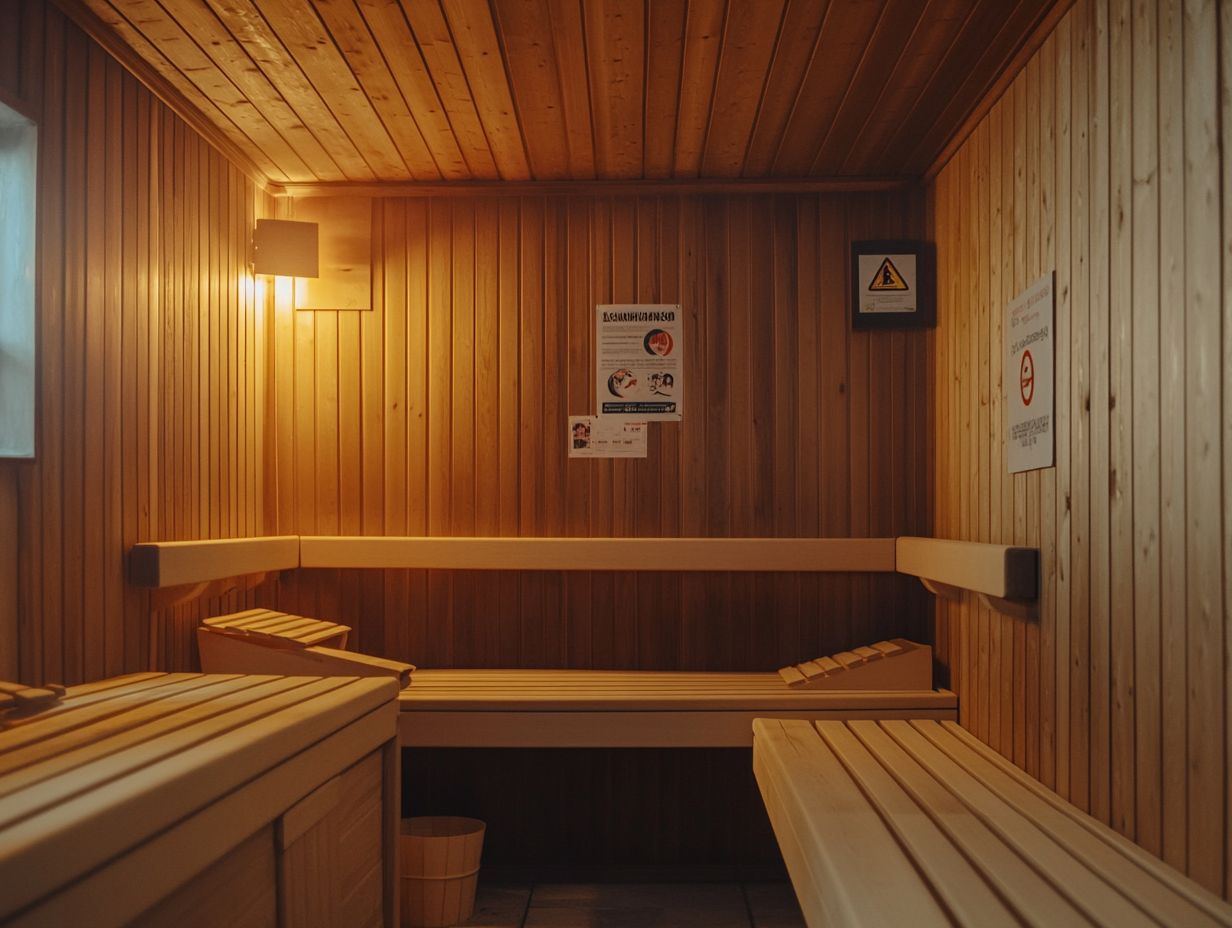Sauna Safety: Building a Strong Foundation
Saunas have long been revered for their relaxing and restorative qualities. However, their benefits reach far beyond just relaxation. From enhancing physical health to uplifting mental well-being, the advantages of regular sauna use are extensive.
This article delves into the different types of saunas, essential safety precautions, and the best practices to ensure a rewarding experience. It also highlights potential risks and how to mitigate them, empowering you to create a safe and enjoyable sauna routine that maximizes its remarkable benefits.
Contents
- Key Takeaways:
- The Benefits of Sauna Use
- Types of Saunas and Their Features
- Precautions for Sauna Use
- Important Safety Measures
- Preparing for a Sauna Session
- Best Practices for Sauna Use
- Potential Risks of Sauna Use
- Identifying and Addressing Risks
- Building a Strong Foundation for Sauna Safety
- Frequently Asked Questions
- What materials should be used when building a sauna’s foundation?
- Can I build a sauna without a foundation?
- How can I ensure my sauna’s foundation is strong enough?
- Are there any additional safety measures to consider when building a sauna’s foundation?
- What should I do if I notice any cracks or damage to my sauna’s foundation?
Key Takeaways:

- Understand the physical and mental benefits of using a sauna, such as improved circulation and stress relief.
- Know the different types of saunas and their features to make an informed decision on which one is best for you.
- Take important safety measures and follow best practices to ensure a safe and enjoyable sauna experience.
The Benefits of Sauna Use
Using a sauna presents a wealth of benefits that go far beyond simple relaxation. It s a cornerstone of wellness routines in various cultures, especially in countries like Finland, Germany, and Sweden, where this practice has been cherished for centuries.
Regular sauna sessions enhance your health in remarkable ways. They improve circulation, aid detoxification, and provide significant stress relief. It becomes a sanctuary for your physical and mental rejuvenation.
Moreover, sauna heat can elevate your overall quality of life. It transforms an ordinary outdoor space into a personal oasis that fosters health and wellness.
Physical and Mental Health Benefits
The physical and mental health benefits of sauna use are extensive. They offer remarkable improvements in circulation, detoxification, and stress relief essential elements for your overall wellness.
In a sauna, the heat helps your body regulate its temperature better. Many users find that regular sauna visits lead to better air quality in their lungs. The heat encourages deep breathing and promotes toxin elimination through sweat.
The radiant heat enveloping you in the sauna helps soothe muscles and joints. This delivers a relaxing sensation that counteracts daily stressors. This combination not only boosts your physical resilience but also cultivates a profound sense of mental clarity and tranquility.
Types of Saunas and Their Features
You ll find a variety of saunas, each designed with distinct features that elevate the sauna experience. Take outdoor saunas, for instance; they blend effortlessly into your backyard. They offer not just relaxation, but also a touch of aesthetic elegance that enhances your outdoor space.
Explore Different Sauna Options
Diving into the various sauna options means exploring their construction materials and design. Outdoor saunas often feature durable wood, expertly chosen for insulation while enhancing your thermal experience. This design invites an authentic connection with nature that can be truly refreshing.
You might typically encounter materials like cedar or spruce, each providing its own unique aroma and benefits. In contrast, indoor saunas may incorporate stylish elements like glass or tile. These allow them to blend seamlessly into your modern living spaces while still adhering to essential heat retention principles.
Design features can vary widely, from traditional Finnish styles that prioritize wood-burning stoves to sleek, contemporary infrared models that focus on efficient, targeted heating. Adequate insulation plays a crucial role here. It directly impacts both the sauna’s energy efficiency and the overall comfort you experience during each thermal session.
Precautions for Sauna Use

Taking the necessary precautions for sauna use is essential for ensuring your safety and the longevity of your sauna’s maintenance. This involves paying attention to important factors like proper drainage and adhering to local building permit regulations.
Important Safety Measures
When using a sauna, it’s essential to prioritize important safety measures. Think proper electrical installation, adequate ventilation, and efficient drainage systems to ward off potential hazards!
These considerations are not just formalities; they are vital for creating a safe and enjoyable environment. Always ensure that electrical installations are carried out by qualified professionals. This guarantees compliance with local codes and minimizes the risks associated with faulty wiring.
Proper ventilation is key to maintaining excellent air quality and preventing overheating. Overheating can lead to discomfort or even accidents. An effective drainage system is equally important. It helps manage moisture and prevents water accumulation, reducing the risk of mold growth and prolonging the sauna’s lifespan.
By focusing on these aspects, you ll love your sauna sessions with complete peace of mind.
Preparing for a Sauna Session
Preparing for your sauna session requires adherence to best practices that elevate relaxation and enrich your overall health experience. Begin by taking a cold shower before entering the sauna. This simple step helps acclimate your body and sets the stage for optimal comfort and rejuvenation!
Best Practices for Sauna Use
Best practices for sauna use revolve around crafting a comfortable environment in your private sanctuary and optimizing your heating experience.
To achieve this, consider fine-tuning the temperature to match your personal comfort levels. Typically, aim for a range between 150 F and 195 F. Infusing the space with natural, calming scents through essential oils can elevate relaxation and create a truly enjoyable atmosphere.
Hydration is crucial! Drink water before and after each sauna visit to support your overall health and stave off dehydration.
Engaging in deep, controlled breathing during your sauna session can further enhance the experience. This allows your body to relax and rejuvenate while you bask in the therapeutic heat.
Potential Risks of Sauna Use
While enjoying the myriad health benefits of sauna use, it s crucial to remain aware of potential risks. Pay particular attention to issues that can arise from improper installation and maintenance, such as wood decay and insufficient drainage.
Identifying and Addressing Risks

Identifying and addressing the risks associated with sauna use requires you to ensure a solid foundation and effective drainage systems. Both are essential for maximizing health benefits.
You ll find that proper support structures are crucial for preventing structural damage over time. This consideration extends to the materials you choose. They should be durable enough to withstand the high temperatures and humidity typical of sauna environments.
An efficient drainage system is not just important for removing excess water. It also plays a key role in preventing mold and mildew, which can lead to significant health concerns.
Regularly inspecting these systems allows you to spot potential weaknesses early, ensuring timely maintenance. By prioritizing both foundational integrity and drainage effectiveness, you can fully enjoy a safe sauna experience that is beneficial!
Building a Strong Foundation for Sauna Safety
Establishing a robust foundation for sauna safety is crucial. Focus on the essential elements of foundation preparation, including the use of high-quality paving stones and ensuring efficient drainage.
These considerations can greatly enhance both safety and longevity, creating a secure environment for your sauna experience!
Take safety measures seriously before your next sauna session!
Creating a Safe and Enjoyable Sauna Experience
Creating a safe and enjoyable sauna experience relies on good safety practices. Well-designed drainage systems and professional installation prevent hazards and enhance satisfaction.
When setting up your sauna, consider various factors such as ventilation, electrical safety, and the right materials. Pay attention to temperature control settings to avoid overheating, which can lead to discomfort or health risks.
Opting for non-slip flooring is a wise choice to prevent accidents as you enter and exit the sauna. Regular maintenance checks are essential for keeping your equipment in top shape.
By embracing these measures, you can cultivate a relaxing atmosphere while minimizing potential dangers, ultimately elevating your sauna experience to new heights.
Frequently Asked Questions
What materials should be used when building a sauna’s foundation?

The most commonly used materials for a sauna’s foundation are concrete, stone, or brick. These materials are strong and durable, ensuring the safety of the sauna.
Can I build a sauna without a foundation?
No, it is not recommended to build a sauna without a foundation. Without proper drainage and insulation, the sauna may not be stable and could pose a safety risk.
How can I ensure my sauna’s foundation is strong enough?
Make sure to talk to a contractor for the best results to ensure the foundation is built to code and can withstand the weight and heat of the sauna. They can inspect and approve the foundation before use.
Are there any additional safety measures to consider when building a sauna’s foundation?
- Ensure the foundation is level and properly insulated to prevent moisture build-up, which can lead to mold or rot.
- Have proper ventilation and drainage systems in the foundation to prevent water damage and ensure good air quality.
What should I do if I notice any cracks or damage to my sauna’s foundation?
If you see cracks in your foundation, act fast! Contact a professional immediately to keep your sauna safe and enjoyable.






